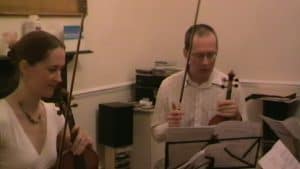Teaching Adults the Violin or Viola
Teaching Adults the Violin or Viola – I’ve taught many adult violinist and violists, some who have come to me as a total beginner (perhaps who had always wanted to learn a stringed instrument but had never had the time or opportunity before), and others who have played for many years or wish to take it up again after a long break. A constant theme that emerges from conversations with mature players goes a little like this:
“…..I used to play when I was young but I had a strict teacher who used to make me practice and play a certain way….” I don’t know if these observations are the result of teaching practices that were prevalent in years gone by, or whether there are still many teachers out there who teach with a rigid and disciplinarian approach. What I do feel though, is that the best way to learn any instrument is by being inspired. The inspiration can come from the possibilities which are opened up for a pupil, as well as the feeling that the teacher has faith in the pupil. After all, teaching is a co-operative pastime with both parties helping the process along. Therefore, I believe good teaching occurs when the pupil is inspired with confidence, but also realistically informed about what will be needed on their part in order to achieve improvement.
Adults learn in a different way to children (and boys have been discovered to generally learn in different ways from girls), and a good violin teacher should treat the relationship as one of equals. After all, we’re in our safety zone – teaching something we are extremely familiar with and must place ourselves into the position of learning a very new skill. I imagine myself (for example) how daunting the prospect might be of learning to drive an articulated lorry, or fly a helicopter! Also, as violin students come from literally all walks of life, the pupil will bring in a plethora of amazing¬† life skills that we may not possess, and draw upon these in their understanding of the violin. One main trait of many adult learners is the need to analyse exactly how something functions, before taking it on board. This is a marvellous attitude to bring to violin lessons, just as long as the analysing doesn’t get in the way of the flow of the music! This is very different from young children who may well be unaware of obstacles and therefore play more from ‘feel’ (which is why creating musical games is an enjoyable way of them overcoming potential challenges).
Another aspect of teaching adult musicians – particularly adults who have achieved much in their chosen profession – is overcoming what are sometimes destructive feelings of self criticism. Adult pupils can feel ‘silly’ for not getting it right first time, guilty for not having found time to practice much during the week, or generally down on themselves for not being better. This is a cultural thing – we are constantly given the opportunity to listen to some of the worlds greatest players via Classic FM, Radio 3, CD recordings and high level concerts by chamber ensembles such as a string quartet – and many adult learners are dismayed at how radically different the violin can sound in their hands. What needs to be emphasised from the very beginning is the feeling of us all being on a journey and enjoying every step, instead of spending that journey forever fixed on the ‘finished product’ – which even seasoned professionals sometimes never feel they attain as we are constantly refining, strengthening and improving, rather like an athlete.
Playing the violin or viola can be a wonderfully life enriching journey, and our mission as teachers is to inspire our pupils to enjoy every note they play. Staying in the moment is the key.

